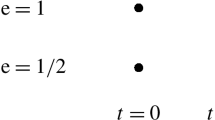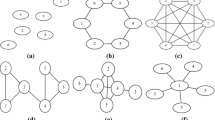Abstract
In this electronic era, most businesses, especially e-businesses like IT services, business process outsourcing (BPO), online merchants etc. maintain details of daily operations and customer feedback. Relations between different business parameters can be learned from these data, which in turn can be used in decision making. In this work, we develop a stylized mathematical framework for business operations based on the knowledge gathered from past data. Our proposed framework is generic and is close to optimal in terms of long-term profitability. In optimizing long-term profit, we balance between short-term profit and long-term reputation earned based on customer satisfaction while ensuring trade secrecy. Towards this we build on stochastic control and Lyapunov techniques that have been successfully applied in communication networks.



Similar content being viewed by others
Notes
The case of stochastic policies is discussed in Sect. 3.2.
References
Baccelli F, Brémaud P (2013) Elements of queueing theory: Palm Martingale calculus and stochastic recurrences, vol 26. Springer, Berlin
Boyd S, Vandenberghe L (2004) Convex optimization. Cambridge University Press, Cambridge
Chatterjee A, Ying L, and Vishwananth S (2012) Revenue and reputation: a stochastic control approach to profit maximization. pp 617–623. doi:10.1109/Allerton.2012.6483275
Chen Y, Xie J (2008) Online consumer review: word-of-mouth as a new element of marketing communication mix. Manag Sci 54:477–491
Clemons EK (2008) How information changes consumer behavior and how consumer behavior determines corporate strategy. J Manag Inf Syst 25:13–40
Cristianini N, Shawe-Taylor J (2000) An introduction to support vector machines and other kernel-based learning methods. Cambridge university press, Cambridge
Davenport TH, Harris JG, Kohli AK (2001) How do they know their customers so well? MIT Sloan Manag Rev 42(2):63
Dellarocas C (2003) The digitization of word of mouth: promise and challenges of online feedback mechanisms. Manag Sci 49:1407–1424
Dorfman R, Steiner PO (1954) Optimal advertising and optimal quality. Am Econ Rev 44:826–836
Fox V (2010) Marketing in the age of google: your online strategy is your business strategy. Wiley, New York
Kimes SE (1999) The relationship between product quality and revenue per available room at holiday inn. J Serv Res 2:138–144
Kotowitz Y, Mathewson F (1979) Advertising, consumer information, and product quality. Bell J Econ 10:566–588
Lambin J, Naert PA, Bultez A (1975) Optimal marketing behavior in oligopoly. Eur Econ Rev 6:105–128
Luca M (2010) Reviews, reputation, and revenue: the case of yelp.com. Technical report, Harvard Business School
Nagar V, Rajan MV (2001) The revenue implications of financial and operational measures of product quality. Account Rev 76:495–513
Neely MJ (2010) Stochastic network optimization with application to communication and queueing systems. Morgan and Claypool, San Rafael
Neely MJ, Modiano E, Li C (2005) Fairness and optimal stochastic control for heterogeneous network. In: Proceedings of IEEE INFOCOM, vol. 3, Miami, FL, pp 1723–1734
Nerlove M, Arrow KJ (1962) Optimal advertising policy under dynamic conditions. Economica 29:129–142
Resnick P, Zeckhauser R, Swanson J, Lockwood K (2006) The value of reputation on ebay: a controlled experiment. Exp Econ 9:79–101
Rust RT, Moorman C, Dickson PR (2002) Getting return on quality: revenue expansion, cost reduction, or both? J Mark 66:7–24
Schal M (1993) Average optimality in dynamic programming with general state space. Math Oper Res 18(1):163–172
Sethi SP, Thompson GL (2000) Optimal control theory: applications to management science and economics. Springer, Berlin
Sethuraman R, Tellis GJ (1991) An analysis of the tradeoff between advertising and price discounting. J Mark Res 28:160–174
Srikant R, Ying L (2013) Communication networks: an optimization, control, and stochastic networks perspective. Cambridge University Press, Cambridge
Stokey NL (2008) The economics of inaction: stochastic control models with fixed costs. Princeton University Press, Princeton
Varshney K, Mojsilovic A (2011) Business analytics based on financial time series. IEEE Signal Process Mag 28(5):83–93
Weigelt K, Camerer C (1988) Reputation and corporate strategy: a review of recent theory and applications. Strateg Manag 9:443–454
Zeidler E (2013) Nonlinear functional analysis and its applications: iii: variational methods and optimization. Springer, Berlin
Author information
Authors and Affiliations
Corresponding author
Rights and permissions
About this article
Cite this article
Chatterjee, A., Ying, L. & Vishwanath, S. Trading revenue, reputation and trade secrets: a stochastic control framework for business operation. Oper Res Int J 20, 247–278 (2020). https://doi.org/10.1007/s12351-017-0323-8
Received:
Revised:
Accepted:
Published:
Issue Date:
DOI: https://doi.org/10.1007/s12351-017-0323-8




